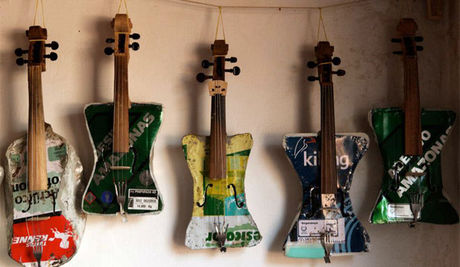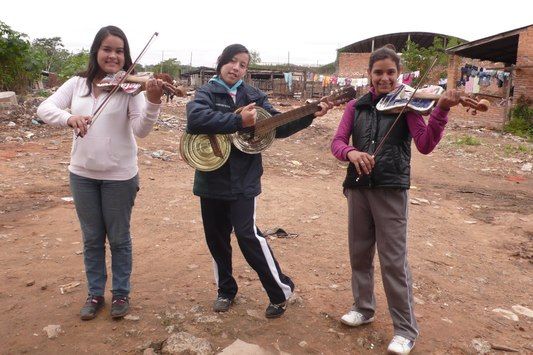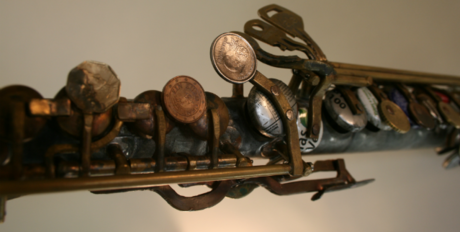Cognition
Landfill Harmonic: Lessons in Improvisation
Documenting transformation and renewal in Cateura, Paraguay
Posted November 26, 2013

Recycled violins made from discarded materials © Landfill Harmonic http://www.landfillharmonicmovie.com/
On the first day of class in my ‘Psychology of Music’ course, I often ask students to create their own musical instruments. The catch is... they have to make them out of whatever they happen to have in their backpacks and pockets that day.
They blow into pen-caps, scrape the spiral spines of notebooks, attach keys to jangle from ankles, drink just the right amount of water from water-bottles to strike the tones of a scale with pens ... and create music in many inventive ways.
I divide them into small goups to perform a short piece together. Rcent highlights: Katy Perry's "Firework" played on water bottles and Beethoven's "Ode to Joy" on marimba of pencils.
The Recycled Orchestra
The makeshift bands serves as an ice-breaker on the first day of class. More importantly, I want my students to open their ears to sound - and discover that pitch and rhythm and timbre reside in everyday things.
So imagine how moved I was to watch a recent episode of '60 Minutes' and discover the 'Recycled Orchestra' of Cateura, Paraguay. I learned that Cateura is a village built on a landfill, and that it is one of the poorest areas in Latin America. Most of the residents make a living by sorting garbage in the landfill for the recycling industry, dragging bags for miles on foot to deliver for a few cents.
Some years ago, a man named Favio Chávez opened a music school in Cateura with the hope of giving the children a sense of purpose and keeping them off the streets. As the students owned no instruments, Favio and another resident began to handmake instruments out of pieces of discarded trash - creating a 'Recycled Orchestra'.
Flutes, guitars, violins, cellos, clarinets, saxophones ... all made out of trash??! I was riveted.

Girls playing instruments made of recycled parts © Landfill Harmonic http://www.landfillharmonicmovie.com
The astonishing story is captured in a forthcoming documentary entitled ‘Landfill Harmonic’. I found the trailer here (length 3:27 mins) Apparently, it has gone viral!
Flexible Thinking
This story beautifully illustrates resistance to a cognitive bias known as ‘functional fixedness’. Identified by Karl Duncker in 1945, functional fixedness refers to our tendency to see objects only in terms of their typical use.
Most of us would not think of using coat buttons, bottle-caps, and door-keys, to make the keys of a flute...

Flute keys made from discarded materials © Landfill Harmonic http://www.landfillharmonicmovie.com/
Infants are not yet susceptible to functional fixedness. They naturally use their senses and motor actions to explore all the possibilities of an object.
Gradually children learn ‘what objects are for’, and with this gain comes a loss in flexible thinking. By about age 6 years, children succumb to ‘functional fixedness’.
How would you do on this test?
German and Defeyter (2000) gave 5, 6, and 7 year-old children this puzzle: A puppet has to reach a high shelf but is not tall enough. Nearby, there is a box containing these objects- a coin, pencil, eraser, bricks, and a toy car. What should the puppet do? (And by the way, the bricks themselves are not tall enough to boost the puppet). Respond before continuing.
Answer: Turn over the cardboard box and use it as a platform for the brick tower. When the problem was presented in this manner, the 5 year-olds were more likely to solve the problem correctly than the 6- and 7 year-olds (who were more likely to be primed to think of the box only as a 'container', as the other objects had been packed inside the box).
If you didn't think about using the box as a stepstool, or didn't even really notice the box in the description as you assumed it was just housing the objects of interest - you also fell prey to 'functional fixedness'. (Don't worry- this would be typical of adults and it doesn't mean you're not creative).
LIFE Requires Improvisation
The Recycled Orchestra is a sparkling example of how resisting ‘functional fixedness’ opens up a new world of possibilities. Forks anchor violin strings. A discarded pipe - and a handful of old buttons, bottlecaps, and door-keys - takes the shape of a saxophone ...

Saxophone made of recycled parts © Landfill Harmonic http://www.landfillharmonicmovie.com/
A rusty oil-can, some discarded wood, a meat tenderizer, and a tool for shaping pasta makes a cello with a rich tone, on which Bach's Cello Suite no. 1 can be played with great musical sensitivity...

'Bebi' plays a cello made of recycled parts © Landfill Harmonic http://www.landfillharmonicmovie.com/
Beyond mere functional fixedness, objects that have been labeled as 'trash', 'useless', 'without value,' are re-imagined and re-assigned as meaningful, functional, and vital. This requires another kind of flexibility beyond functional fixedness - a significant shift of perspective and reframing of meaning.
The word 'bricolage' - the construction of something from whatever happens to be at hand - comes to mind. Out of necessity, Favio and 'Cola' used whatever happened to be available to fashion musical instruments. Not having access to the parts they needed, they improvised, and created something magical.

Tania playing violin made of recycled parts © Landfill Harmonic http://www.landfillharmonicmovie.com/
As I read more about the story behind the documentary, I learned that the film-makers too had improvised. Initially, they had set out to make a documentary about the 'underserved children of Paraguay' and only later found out about the 'Recycled Orchestra'. Imagine if they had stuck to a fixed plan, rather than taken the paths that opened up along the way.
Perhaps, I began to think, life requires this sort of flexibility and improvisation from us - a spirit of 'bricolage'. Maybe it's not a matter of waiting for everything to come together in complete sets, but about cobbling something useful and beautiful together from whatever comes our way.

Recycled violins made from discarded materials © Landfill Harmonic http://www.landfillharmonicmovie.com/
The people of Cateura transformed trash into musical treasures. And with this alchemy, there came social transformation and renewal. I was thrilled to learn that the Recycled Orchestra has traveled abroad to perform in great concert halls, is being tutored by top musicians, and that a world tour is being planned. This is a story that lifts the human spirit and reflects the power of music and creativity for enriching the lives of youth and a whole community, and in turn, all of us.
And for me personally, it serves as a reminder that life requires a spirit of improvisation. I may not always have everything in place before making the next move. Sometimes it's about finding beauty and value in whatever's available at the time in order to re-imagine our lives.
- © 2014 Siu-Lan Tan Ph.D, co-author of Psychology of Music: From Sound to Significance (Psychology Press 2010, 2013) and co-editor of The Psychology of Music in Multimedia (Oxford University Press 2013).
BLOG by Siu-Lan Tan http://www.psychologytoday.com/blog/what-shapes-film
References/Sources
All images are from http://www.landfillharmonicmovie.com/
Documentary trailer: http://www.landfillharmonicmovie.com/
'60 Minutes' story (Nov 17): http://www.cbsnews.com/news/the-recyclers-from-trash-comes-triumph/
Duncker, K. (1945). On problem solving. Psychological Monographs, 58, 5 (whole no. 270).
German, T.P. & Defeyter, M.A. (2000). Immunity to functional fixedness in young children. Psychonomic Bulletin & Review, 7, 707-712.
Defeyter, M.A. & German, T.P. (2003). Acquiring an understanding of design: evidence from children’s insight problem-solving. Cognition, 89, 133-155.
Note In the German & Defeyter 2000 study: in another condition the box was presented as empty - and there were no significant differences between the age groups, as the idea of 'box' as 'container' was not primed. For a detailed explanation for why differences were found between 5 year-olds and older children in the primed condition, see their 2003 paper.




